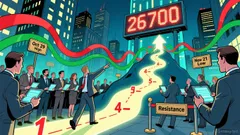In the dynamic world of sportswear, two giants have been locked in a fierce competition for market dominance: Puma and Adidas. However, in recent years, the gap in their share price performance has been widening, leaving investors and analysts alike wondering what factors have contributed to this disparity. Let's dive into the key aspects that have driven this trend.
Firstly, Adidas has been on a roll with its innovative product offerings and strategic partnerships. The company's successful reinvention of its brand image, coupled with high-profile collaborations with athletes and celebrities, has driven consumer demand and boosted sales. For instance, Adidas' partnership with Kanye West's Yeezy brand contributed significantly to its growth until its discontinuation in 2022. In contrast, Puma has struggled to maintain a strong brand image and has not been as successful in product innovation.
Secondly, Adidas has consistently shown strong growth in market share, both globally and in key regions. In 2024, Adidas reported a 12% increase in currency-neutral revenues, driven by strong demand for its products across both Lifestyle and Performance categories, as well as in all regions and divisions. Puma, on the other hand, has not been able to match this level of growth, with its revenue growth being relatively slower.
Thirdly, Adidas has made significant strides in improving its operational efficiency and cost management. The company has successfully reduced high inventory levels and implemented a conservative sell-in strategy, which has helped it to improve its gross margin. In 2024, Adidas' gross margin increased by 3.3 percentage points to 50.8%. Puma, however, has struggled with operational inefficiencies and has not been able to achieve the same level of cost management.
Lastly, Adidas' CEO, Bjørn Gulden, has been credited with turning the company around and implementing a successful strategic vision. Under his leadership, Adidas has focused on improving its product offerings, strengthening its brand image, and enhancing its operational efficiency. Puma, however, has not had the same level of consistent leadership and strategic vision.
In conclusion, the widening gap in share price performance between Puma and Adidas can be attributed to several key factors, including Adidas' successful brand reinvention, strong revenue growth, operational efficiency, and effective leadership. As the competition between these two sportswear giants continues, investors and analysts will be keeping a close eye on their respective strategies and performance to determine which company will emerge as the ultimate winner in the market.







Comments
No comments yet